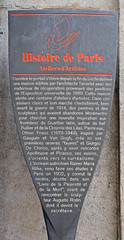Rainer Maria Rilke
Commemorated on 3 plaques
Dans cet hôtel ou il fit découvrir à Auguste Rodin, Rainer Maria Rilke vécut de 1908 à 1911
English translation: In this building, where he first discovered Auguste Rodin, lived Rainer Maria Rilke from 1908 to 1911
79, rue de Varenne, Paris, France where they lived (1908-1911)
Ateliers d'Artistes Derrière le portail s'élève depuis la fin du siècle dernier une maison édifiée par l'architecte Taberlet avec des matériaux de récupération provenant des pavillons de l'Exposition universelle de 1889. Cette maison abrite une centaine d'ateliers d'artistes. Dans ces ateliers clairs et bon marché s'installèrent, bien avant la guerre de 1914, des peintres et des sculpteurs qui avait abandonné Montmartre pour chercher une nouvelle inspiration aux frontières du Quartier latin, autour du bal Bullier et de la Closerie des Lilas. Parmi eux, Othon Friesz (1879-1949), inspiré par Gauguin et Van Gogh, créa ici ses premières oeuvres "fauves" et Giorgio De Chirico, après y avoir rencontré Apollinaire et Picasso, ses voisins, s'orienta vers le surréalisme. L'écrivain autrichien Rainer Maria Rilke, venu faire ses études à Paris en 1902, y connut la misère, décrite dans son "Livre de Pauvreté et de la Mort", avant de rencontrer le sculpteur Auguste Rodin dont il devint le secrétaire.
English translation: Artists' Workshops Behind the portal has since the end of the last century been a house built by the architect Taberlet with recovery materials from the pavilions of the Universal Exhibition of 1889. This house houses about 100 artists' workshops. In these clear and inexpensive workshops, long before the War of 1914, painters and sculptors who had abandoned Montmartre to seek new inspiration at the borders of the Latin Quarter, around the Bullier Ball and the Closerie des Lilas. Among them, Othon Friesz (1879-1949), inspired by Gauguin and Van Gogh, created his first “fake” works here and Giorgio De Chirico, after meeting Apollinaire and Picasso, his neighbours, moved towards surrealism. Austrian writer Rainer Maria Rilke, who came to Paris in 1902, experienced poverty, described in his “Book of Poverty and Death”, before meeting the sculptor Auguste Rodin, of whom he became secretary. [AWS Translate]
9 rue Campagne-Première, Paris, France where they worked (1902)
Dans l'effervescence créatrice des années 1920, l'hôtel Istria accueillit, entre autres artistes, Francis Picabia, Marcel Duchamp, Moïse Kisling, peintres, Man Ray, photographe, Kiki de Montparnasse, modèle et égérie, Erik Satie, compositeur, Rainer Maria Rilke, Tristan Tzara, Vladimir Maïakovski, poètes, et Louis Aragon qui y rejoignait Elsa Triolet. "Ne s'éteint que ce qui brilla ... Lorsque tu descendais de l'hôtel Istria, Tout était différent Rue Campagne Première, En mil neuf cent vingt neuf , vers l'heure de midi ..." Louis Aragon (Il ne m'est Paris que d'Elsa.)
English translation: In the creative effervescence of the 1920s, Hotel Istria welcomed, among other artists, Francis Picabia, Marcel Duchamp, Moïse Kisling, painters, Man Ray, photographer, Kiki de Montparnasse, model and mighty, Erik Satie, composer, Rainer Maria Rilke, Tristan Tzara, Vladimir Maiakovski, poets, and Louis Aragon who joined there Elsa Triolet. “Only that which shone... When you came down from the Hotel Istria, Everything was different in Rue Campagne Première, in 1929, around noon...” Louis Aragon (I'm Paris only from Elsa.)
29 rue Campagne-Première, Paris, France where they worked




